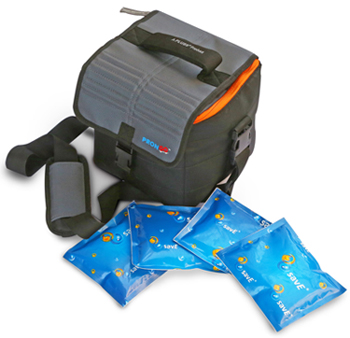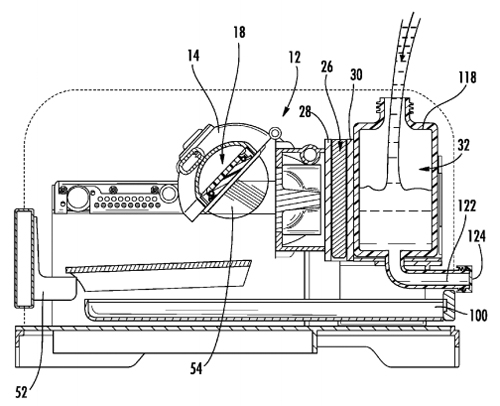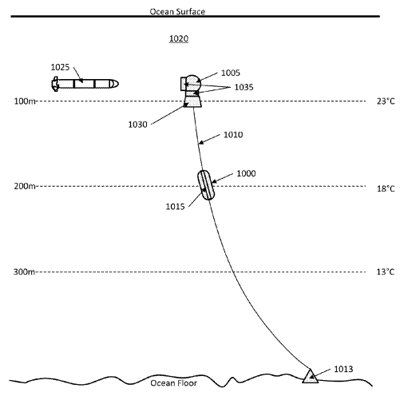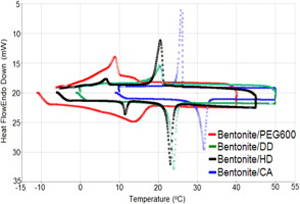 The Phase Change Matters e-mail newsletter is a weekly summary of the latest news and research on phase change materials and thermal energy storage. To subscribe, visit www.puretemp.com/subscribe. For more frequent updates, follow @puretemp on Twitter or visit the Phase Change Matters blog, www.puretemp.com/pcmatters.
The Phase Change Matters e-mail newsletter is a weekly summary of the latest news and research on phase change materials and thermal energy storage. To subscribe, visit www.puretemp.com/subscribe. For more frequent updates, follow @puretemp on Twitter or visit the Phase Change Matters blog, www.puretemp.com/pcmatters.
REGULATORY
EPA reduces reporting requirements for 6 biobased chemicals
Manufacturers of several biobased chemicals, including various fatty acids, have reduced reporting requirements under an Environmental Protection Agency rule signed this week. Processing and use information will not need to be submitted for these six chemicals, according to a report in Bloomberg BNA’s Chemical Regulation Reporter:
• Fatty acids, C14-18 and C16-18 unsaturated, methyl esters (CAS No. 67762-26-9)
• Fatty acids, C16-18 and C-18 unsaturated, methyl esters (CAS No. 67762-38-3)
• Fatty acids, canola oil, methyl esters (CAS No. 129828-16-6)
• Fatty acids, corn oil, methyl esters (CAS No. 515152-40-6)
• Fatty acids, tallow, methyl esters (CAS No. 61788-61-2)
• Soybean oil, methyl esters (CAS No. 67784-80-9)
The rule would save manufacturers time and allow them to qualify for an exemption granted to manufacturers of petroleum-based versions of the chemicals, the executive director of the Biobased and Renewable Products Advocacy Group told Bloomberg. The group petitioned the EPA for the exemption.
The full report is available on Chemical Regulation Reporter, a subscription-based service.
NEW PRODUCTS
PronGO bag uses PCM-filled pouches to keep ice cream solid on hot days
Afraid your ice cream will melt on the walk home from the supermarket or on the way to a summer picnic? Pluss Advanced Technologies of Gurgaon, India, has a solution: PronGO, an insulated bag designed to keep frozen food frozen for up to five hours in hot conditions.
 Multilayered film pouches containing phase change material fit in pockets inside the 3-liter bag. The flat pouches are about 100mm by 150mm. The PCM temperature range is -10 to -18 degrees Celsius.
Multilayered film pouches containing phase change material fit in pockets inside the 3-liter bag. The flat pouches are about 100mm by 150mm. The PCM temperature range is -10 to -18 degrees Celsius.
In an interview with Phase Change Matters, Vishnu Sasidharan, vice president of new product initiatives at Pluss, says the bag will be available on Amazon next month for about $39 USD. He says it’s the first product Pluss has designed for the retail market.
Pluss is planning to introduce versions designed for three other temperature ranges, using either salt hydrate or biobased PCMs, depending on temperature requirements:
• +2° to +8° C (dairy products, fruits and vegetables),
• -2° to -10° C (raw meat and sea food)
• +15° to +25° C (chocolates and confectionary)
A promotional video advises users to chill the pouches a minimum of 36 hours in a freezer set to maximum cooling. Sasidharan says the PCM can solidify in as little as 12 hours in a household freezer compartment. The longer duration represents a “worst case scenario considering different models of refrigerator vary in performance.”
PATENTS
Thermoelectric ice maker with phase change material
 U.S. patent application 20160084558 (applicant Whirlpool Corp., Benton Harbor, Mich.):
U.S. patent application 20160084558 (applicant Whirlpool Corp., Benton Harbor, Mich.):
“An ice maker has a mold with a first piece and a second piece. A cavity within the mold includes a first reservoir in the first piece and a second reservoir in the second piece that align to substantially enclose the cavity. A fluid intake aperture in the first piece extends to the cavity for injecting water therein. A thermoelectric device has a cold side thermally coupled to the exterior surface of the second piece. The thermoelectric device transfers heat from the cold side to a hot side to provide a first temperature to the mold. … The object of the present invention is achieved by the use of a phase change material for the production of a sterile state indication means, a sterile state indication means and a sterilization container as described herein.”
Regenerative vehicle A/C system with PCMs
U.S. patent application 20160047562 (applicant Matthew Bartlett, Northville, Mich.):
“A regenerative air conditioning system for a vehicle includes a condenser, a compressor, an evaporator subsystem, an expansion valve, and a solenoid controlled expansion valve arranged and coupled together in a direct expansion cooling circuit. The evaporator subsystem has a main evaporator and a storage evaporator. The storage evaporator has a phase change material therein surrounding refrigerant passages in the storage evaporator.”
Life cradle device for inducing neonatal hypothermia
U.S. patent application 20160051403 (applicant Pluss Advanced Technologies, Gurgaon, India):
“The present invention relates to a life cradle device for the purpose of inducing therapeutic hypothermia in neonates suffering from birth asphyxia. The device essentially consists of a rigid outer skeleton which could be fitted with removable mattresses containing form stable organic phase change materials effecting instant and sustained cooling. Multiple compartments of different phase change material composition functional at different temperatures are arranged in layers to replicate cooling performances as in conventional cascading systems.”
Phase change device for use within a volume of fluid
 U.S. patent application 20160047362 (applicant Ideal Innovations Inc., Arlington, Va.):
U.S. patent application 20160047362 (applicant Ideal Innovations Inc., Arlington, Va.):
“A phase-change device for use in a volume of fluid, comprising a pressure vessel; a displacement cylinder; a displacement piston; a drive cylinder containing a phase-change material; a drive piston; and a gas spring. As the device sinks and experiences cooler fluid temperatures, the phase change material reduces in volume, causing the drive cylinder to move relative to the drive piston and thereby exert an outward force on the displacement piston. The displacement piston is pulled away from the displacement cylinder, increasing the overall displacement of the device. The increase in displacement increases the buoyancy of the device, thereby causing the device to rise in the fluid.”
IN BRIEF
• The Royal Society of Chemistry’s Formulation Science and Technology group will hold its second Innovations in Encapsulation conference on June 10 in Edinburgh, Scotland. Speakers include Paula Felix De Castro and Dmitry G. Shchukin of Liverpool University. They will present their work on encapsulation of docosane into polyurethane microcapsules as phase change material for thermal energy storage.
 • Nidhi Agrawal, right, assistant R&D manager at Pluss Advanced Technologies, is among eight people named to the India edition of MIT Technology Review‘s 2015 list of Innovators Under 35. Agrawal, 32, has led the development of several phase change materials, including form-stable materials.
• Nidhi Agrawal, right, assistant R&D manager at Pluss Advanced Technologies, is among eight people named to the India edition of MIT Technology Review‘s 2015 list of Innovators Under 35. Agrawal, 32, has led the development of several phase change materials, including form-stable materials.
• The Los Angeles Times takes a look at SolarReserve‘s Crescent Dunes solar power plant, a 110-megawatt facility with enough molten salt storage to power 75,000 homes for up to 10 hours with zero sunshine.
• New from QYResearch Group: “Europe Phase Change Materials Industry 2016 Market Research Report”
• ARPA-E is seeking candidates for a number of openings in Washington, D.C.: senior advisor for technical assessment and impact; program director; technology to market advisors; ARPA-E fellows and technology-to-market scholars.
• PCM manufacturer RGEES has posted an opening for a production technician at its plant in Arden, N.C.
• Software maker COMSOL outlines a procedure for thermally modeling a material with hysteresis, which means that the melting temperature is different from the solidification temperature.
• Global investment in renewable energy hit a record $286 billion in 2015, according to a report from the United Nations Environment Program. Developing economies accounted for nearly 55 percent of the total. It’s a different story in Europe, evidently. The Guardian reports that the clean technology industry there “has fallen into a rapid decline, with investment in low-carbon energy last year plummeting to its lowest level in a decade.”
RESEARCH ROUNDUP
For our full list of recent academic research, see puretemp.com/academic. Here are highlights from the past week:
From Applied Energy:• Preparation of paraffin/porous TiO2 foams with enhanced thermal conductivity as PCM, by covering the TiO2 surface with a carbon layer
• Microencapsulation of phase change materials with binary cores and calcium carbonate shell for thermal energy storage
 From Energy Conversion and Management:
From Energy Conversion and Management:• Thermal energy storage characteristics of bentonite-based composite PCMs with enhanced thermal conductivity as novel thermal storage building materials
From Renewable and Sustainable Energy Reviews:
• A review on phase change material (PCM) for sustainable passive cooling in building envelopes
From Journal of Heat Transfer:
• Experimental Characterization of Inward Freezing and Melting of Additive-Enhanced PCM within Millimeter-scale Cylindrical Enclosures
From Proceedings of Mechanical Engineering Research Day 2016:
• Preparation and characterization of form-stabilized paraffin/polycaprolactone (PCL) composites as phase change materials
From Asian Journal of Chemistry:
• New Approach of Phase Change Material Encapsulation through in situ Polymerization to Improve Thermo-Regulating Property of Cellulose
From Chemical Engineering Journal:
• Thermal conductivity enhancement of polyethylene glycol/expanded vermiculite shape-stabilized composite phase change materials with silver nanowire for thermal energy storage
From Materials:
• On the Behavior of Different PCMs in a Hot Water Storage Tank against Thermal Demands
NETWORKING
Connect with PCM experts and industry leaders on LinkedIn
More than 650 of your peers have joined a new LinkedIn group devoted to the discussion of phase change material and thermal energy storage. The Phase Change Matters group is an interactive complement to the award-winning blog and newsletter of the same name.
You are invited to join the group and connect with PCM and TES experts from around the world. New members this week include Philipp Schütz, lecturer at Hochschule Luzern in Switzerland; Sean Hoenig, R&D engineer at Advanced Cooling Technologies in Pennsylvania; Kelvin Chua, business development manager at Pelican BioThermal in Singapore; and Vikrant Aute, associate research scientist at the University of Maryland. Vikrant started a new discussion, asking:
“Please can anyone recommend a COTS simulation tool for CENG integrated PCM storage?”
Gaurav Kale, packaging expert at Blue Apron in New York, offered the first reply:
“This could be it – http://www.valentin-software.com/en.”
YOUR TURN
Wanted: News tips about PCMs and thermal energy storage
Does your company, agency or university have a job opening, new research, new product or other news you’d like to share? We would love to hear from you. Please contact Ben Welter of Entropy Solutions at bwelter@puretemp.com.